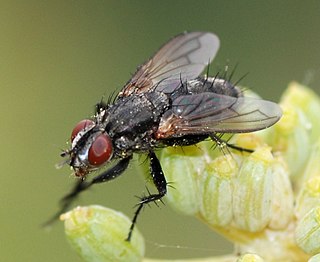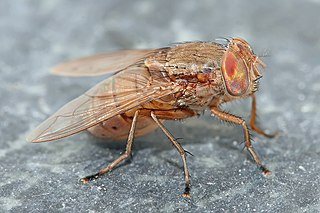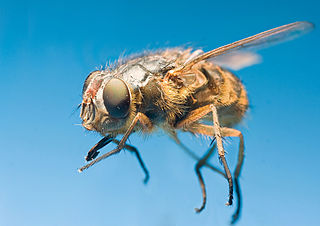
The Calliphoridae are a family of insects in the order Diptera, with 1,200 known species. The maggot larvae, often used as fishing bait, are known as gentles. The family is known to be polyphyletic, but much remains disputed regarding proper treatment of the constituent taxa, some of which are occasionally accorded family status.

Oestroidea is a superfamily of Calyptratae including the blow flies, bot flies, flesh flies, and their relatives.

Rhinophoridae is a family of flies (Diptera), commonly known as Woodlouse Flies, found in all zoogeographic regions except Oceania, but mainly in the Palaearctic and Afrotropical regions.

Bengalia is a genus of blow flies in the family Calliphoridae with one authority considering the genus to belong to a separate family Bengaliidae. These bristly and, unlike the greens and blues of most calliphorids, dull coloured flies, are especially noted for their relationship to ants. Little is known of their biology and life-cycle, although adults of many species are kleptoparasitic on ants and will snatch food and pupae being carried by ants or feed on winged termites. The apt name “Highwayman Fly” was given by an early observer of their way of robbing ants. Very little is known about their breeding habits. The genus is found in the Afrotropical and oriental region with one species from Australia possibly a recent introduction.

Stomorhina is a genus of flies in the family Rhiniidae.

The Calliphorinae are a subfamily of the blow fly family Calliphoridae. The distinguishing characteristics of this subfamily are: the stem vein is bare, the lower calypter and the proepisternal depression are bristly, but the suprasquamal region is bare or with only a few random bristles. The thorax is dull and bears fine hairs, and the abdomen is usually colored shining blue.
The Melanomyinae are a subfamily of Calliphoridae, or blow flies. According to Whitworth, the most distinguishing characteristic of this subfamily is its dull color; however, the biology is poorly known.
Melanodexia is a peculiar New World cluster fly genus of the western United States, formerly included in the family Calliphoridae.

Cordylobia is a genus of flies from the family Calliphoridae. The larvae of Cordylobia are parasitic on mammals, especially rodents. Two species, C. anthropophaga and C. rodhaini, also are known as parasites of humans. The adult flies feed on rotting fruits, vegetables, and animal faeces, and are most abundant in the wet season. Like many tropical insects, they are most active in the morning and evening. Cordylobia species are largely confined to Africa, though they have been recorded elsewhere when transported by human travellers.

Loewia is a genus of flies in the family Tachinidae.

Lophosia is a genus of flies in the family Tachinidae.
Bithia is a genus of flies in the family Tachinidae.
Leucostomatini is a tribe of flies in the family Tachinidae.

Andy Z. Lehrer was a Romanian entomologist. From 1996 until his death, he worked as a research associate in the laboratory of Zoology at the University of Tel Aviv in Tel Aviv, Israel. For several years, he studied flesh flies and blow flies from all over the world.
Cordylobia rodhaini also known as the Lund's fly derived its common name from captain Lund, who was the first European to show symptoms of the disease caused by the larvae of the same fly. The Lund’s fly belongs to the genus Cordylobia, a group of flies from the family Calliphoridae. The larvae of the Lund’s fly are parasites of thinned-skinned mammals, especially the Gambian rat, mona monkey and small antelopes and are only accidental parasites of humans. The adult flies feeds on rotting fruits, vegetables and animal feces, and are most abundant in the wet season. Like many tropical insects they are most active in the dark periods and have the greatest activity early in the morning and late in the evening while resting typically between 8am to 5pm. The Lund’s fly are largely confined to tropical Africa, especially the rainforest areas in Sub-Saharan Africa. However, as a result of human migration, the parasitic infections they cause have been recorded in other continents including Europe and Asia.
Verticia is a genus of flies (Diptera) in the family Calliphoridae. The genus was first described by J.R. Malloch in 1927.
Cosmina is a genus of flies in the family Rhiniidae.

Polleniidae is a family of flies in the order Diptera. There are at least 6 genera and more than 190 described species placed definitively in Polleniidae, and other genera whose placement here is considered uncertain. The largest genus is Pollenia, with close to 190 species of flies commonly called "cluster flies".

Rhiniidae is a family of flies in the order Diptera, and formerly included in the Calliphoridae. There are around 30 genera and 370 described species in Rhiniidae.

Mesembrinellidae is a family of Neotropical flies in the order Diptera, and formerly included in the Calliphoridae. There are 36 described species.













